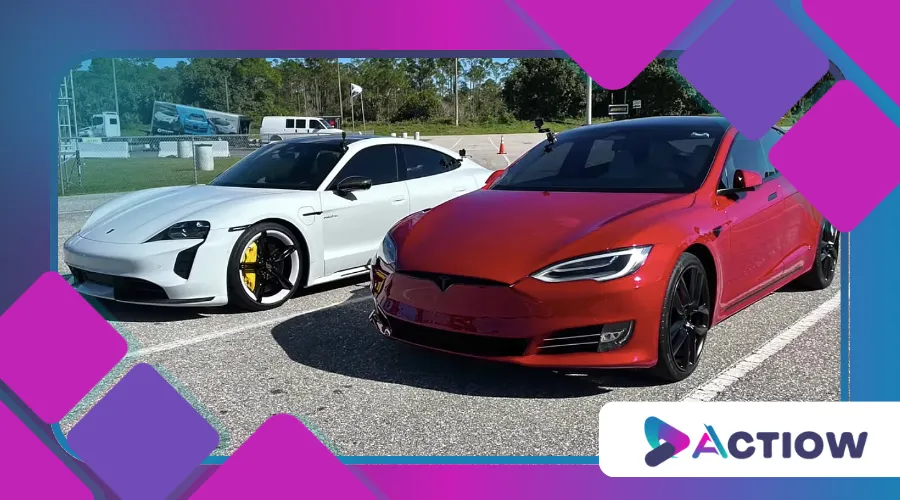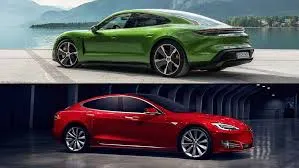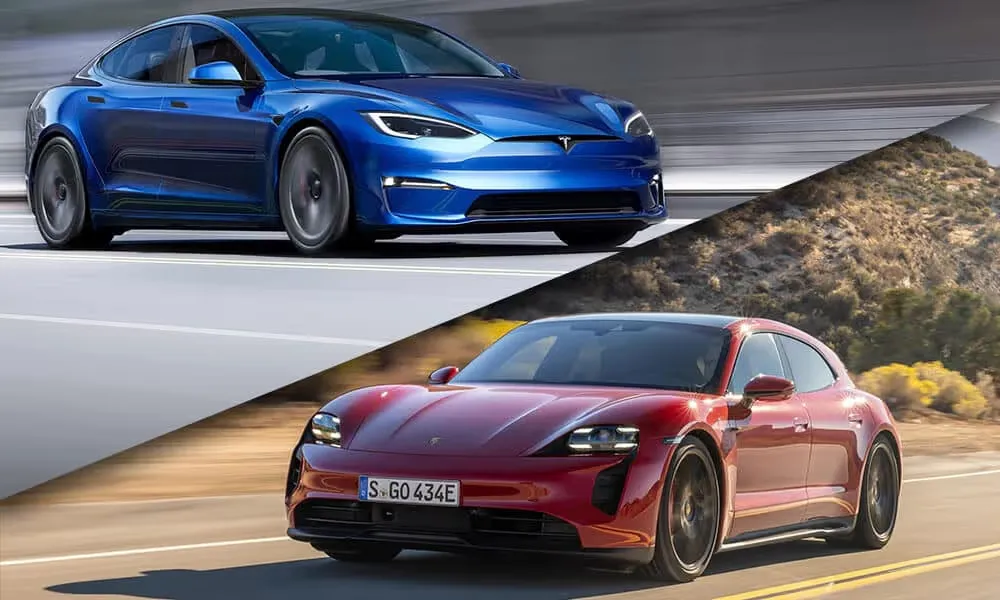Tesla Model S vs Porsche Taycan: High-Performance Electric Cars

Anúncios
In the electrified arena of high-performance cars, Tesla Model S vs Porsche Taycan stands as a clash of titans, each redefining what electric vehicles (EVs) can achieve.
These two machines aren’t just cars; they’re statements of engineering prowess, blending raw power, cutting-edge technology, and polarizing philosophies.
The Tesla Model S, a pioneer that reshaped the automotive landscape, faces off against the Porsche Taycan, a newcomer with a storied brand legacy.
Anúncios
This comparison dives deep into their performance, design, technology, and driving experience to determine which EV reigns supreme in 2025.
Buckle up—it’s a thrilling ride.
Performance: Speed, Power, and Precision
When it comes to raw acceleration, the Tesla Model S Plaid is a force of nature.
With a claimed 0-60 mph sprint in 1.99 seconds, it’s a rocket disguised as a sedan, boasting 1,020 horsepower from its tri-motor setup.
This sheer power delivers neck-snapping launches that feel like being catapulted into hyperspace.
In contrast, the Porsche Taycan Turbo GT, with its 1,019 horsepower (with Launch Control), hits 0-60 mph in 2.2 seconds when equipped with the Weissach Package.
While the Taycan trails slightly in straight-line speed, its two-speed transmission and track-tuned dynamics shine on winding roads.
Porsche’s engineering focuses on sustained performance.
Unlike the Model S, which can suffer power degradation after repeated high-performance runs due to thermal limitations, the Taycan’s advanced battery cooling and robust powertrain maintain consistent output.
A 2020 Car and Driver test revealed the Taycan Turbo S outperformed the Model S in eight of 13 speed tests, including 30-50 mph and 50-70 mph sprints, thanks to its superior grip and power delivery.
The Taycan’s ability to repeat 0-60 mph runs without fading is a testament to Porsche’s motorsport heritage.
Imagine the Tesla Model S vs Porsche Taycan as a duel between a drag racer and a rally champion.
The Model S Plaid storms the quarter-mile in 9.2 seconds at 153 mph, while the Taycan Turbo GT’s agility makes it a track predator, lapping the Nürburgring in 7:07—17 seconds faster than the Model S Plaid.
For drivers who crave corner-carving precision over drag-strip dominance, the Taycan’s superior handling and braking make it the enthusiast’s choice.
Table 1: Performance Comparison
| Metric | Tesla Model S Plaid | Porsche Taycan Turbo GT |
|---|---|---|
| 0-60 mph | 1.99 seconds | 2.2 seconds (Weissach) |
| Top Speed | 200 mph (claimed) | 190 mph |
| Horsepower | 1,020 hp | 1,019 hp (Launch Control) |
| Quarter-Mile | 9.2 seconds @ 153 mph | 10.5 seconds @ 133 mph |
| Nürburgring Lap Time | 7:24 | 7:07 |
Additionally, both vehicles are equipped with advanced technologies that enhance their performance, such as regenerative braking and adaptive suspension systems, which further differentiate their driving experiences.
As the electric vehicle market evolves, these performance metrics will continue to be pivotal in shaping consumer preferences.
Range and Charging: The Long-Distance Debate
Range is a critical factor for EV buyers, and here, the Tesla Model S vs Porsche Taycan reveals stark contrasts.
The Model S Plaid offers an EPA-estimated 396 miles of range, while the Taycan Turbo GT manages 246 miles with the Performance Battery Plus.
However, real-world tests paint a different picture.
A 2020 nextmove Autobahn test showed the Taycan 4S losing only 23% charge over 56 miles at 75 mph, compared to the Model S’s 25%, suggesting the Taycan’s efficiency holds up under spirited driving.
Charging infrastructure is another battleground.
Tesla’s Supercharger network, with over 16,000 chargers in North America, remains unmatched for accessibility.
Yet, the Taycan’s 800-volt architecture allows it to charge at 270 kW, reaching 80% capacity in 22 minutes at compatible stations like Electrify America.
The Model S, capped at 250 kW, takes about 30 minutes for a similar charge.
For road-trippers, Tesla’s network is a game-changer, but the Taycan’s faster charging minimizes downtime for those with access to high-power stations.
Consider this scenario: You’re driving from Los Angeles to San Francisco.
The Model S Plaid’s longer range means fewer stops, but if you hit a high-power charger, the Taycan’s quick top-up could get you back on the road faster.
Which matters more—range or charging speed?
It depends on your journey and priorities.
Moreover, the growing network of fast chargers across the country is enhancing the feasibility of long-distance travel for electric vehicles, making it easier for owners to plan their trips.
As infrastructure improves, the gap between range and charging capabilities may continue to narrow.
+ Ford Ranger vs Toyota Hilux: Which Pickup Is More Durable?
Design and Interior: Minimalism vs. Opulence
The Tesla Model S vs Porsche Taycan design philosophies couldn’t be more different.
The Model S Plaid’s sleek, minimalist exterior has evolved since 2012, but its understated look blends into the EV crowd.
Inside, the controversial yoke steering and 17-inch central touchscreen dominate, creating a futuristic but polarizing cabin.
The interface is intuitive, but the lack of physical buttons can frustrate drivers who prefer tactile controls.
The Taycan, by contrast, is a visual masterpiece.
Its low-slung silhouette, sculpted lines, and iconic Porsche cues—like the four-point LED headlights—scream sophistication.
The interior is a blend of luxury and technology, with up to 41 inches of digital displays, premium leather, and 24 color options.
Unlike the Model S’s limited black, white, or tan “pleather,” the Taycan’s cabin feels bespoke, like a tailored suit versus Tesla’s off-the-rack minimalism.
Picture this: You’re pulling up to a high-end restaurant.
The Model S glides in quietly, unnoticed by valets accustomed to Teslas.
The Taycan, in Frozen Berry with 21-inch wheels, turns heads, its presence commanding respect.
The Porsche’s build quality—solid doors, precise panel gaps—exudes craftsmanship the Model S can’t match.

Table 2: Interior and Customization
| Feature | Tesla Model S Plaid | Porsche Taycan Turbo GT |
|---|---|---|
| Display Size | 17-inch touchscreen | 41-inch combined displays |
| Seating Material | Vegan leather (3 colors) | Leather/Race-Tex (24 colors) |
| Customization Options | 2 wheel options | 8 wheel options, 17 colors |
| Boot Capacity | 28 cu-ft | 14.3 cu-ft |
| Rear Seat Space | Moderate | Ample for four adults |
Furthermore, the choice of materials and the overall aesthetic appeal of each vehicle can significantly influence buyer preferences, as luxury and comfort become increasingly important in the EV market.
As consumers seek more personalized experiences, the interior design will play a crucial role in their decision-making process.
Technology and Driver Assistance: Innovation Meets Tradition
Tesla has long been the tech darling, and the Model S Plaid’s Full Self-Driving (FSD) suite remains a bold, if controversial, feature.
FSD Supervised, as noted in a 2025 X post, can handle complex drives—like a 40-mile hospital trip at 4 a.m.—with minimal driver input, though it’s not fully autonomous.
The Taycan’s InnoDrive, while less ambitious, offers reliable adaptive cruise control and lane-keeping, integrated seamlessly to avoid the false alarms some Tesla owners report.
The Model S’s tech edge lies in its over-the-air updates, which keep the car fresh with new features.
The Taycan, while updatable, leans on Porsche’s driver-focused ethos, with features like the optional Porsche Active Ride for enhanced cornering.
Tesla’s massive touchscreen controls everything, from climate to navigation, but the Taycan’s multiple displays and physical buttons strike a balance between innovation and usability.
Why settle for a car that feels like a gadget when you can drive one that blends tech with soul?
The Taycan’s cockpit, inspired by the 911, makes every drive an event, while the Model S feels like a tech platform on wheels.
Additionally, advancements in driver assistance technologies are reshaping the automotive landscape, making it essential for manufacturers to continuously innovate in this area.
As safety and convenience features improve, they will play a vital role in attracting new customers to electric vehicles.
++ Comparison: BMW 3 Series vs Audi A4 – Luxury Sedans
Driving Experience: Exhilaration or Efficiency?
The Tesla Model S vs Porsche Taycan driving experience hinges on intent.
The Model S Plaid is a straight-line monster, its tri-motor setup delivering instant torque that feels like a rollercoaster drop.
But on twisty roads, its floaty handling and less precise steering pale against the Taycan’s razor-sharp dynamics.
The Taycan Turbo GT’s four-wheel steering, adaptive suspension, and two-speed gearbox make it feel glued to the road, offering a driving thrill Tesla can’t replicate.
For example, navigating California’s Angeles Crest Highway, the Taycan dances through corners with surgical precision, its Electric Sport Sound adding a sci-fi hum that enhances the experience.
The Model S, while fast, feels heavier, less planted, and more like a luxury cruiser than a sports car.
A 2023 Reddit post on r/Taycan noted the Model S “floats” in corners, while the Taycan feels “on rails,” a sentiment echoed by enthusiasts.
Statistically, the Taycan’s superior handling shines in track tests.
In a 2020 Dongchedi track test, the Taycan Turbo lapped 3.29 seconds faster than the Model S Performance, showcasing Porsche’s edge in dynamic performance.
Moreover, the emotional connection drivers feel with their vehicles is becoming increasingly relevant, as enthusiasts seek cars that offer not just performance but also an engaging driving experience.
As the market evolves, the importance of driving dynamics will remain at the forefront of consumer preferences.

Price and Value: Bang for Your Buck
Price is where the Tesla Model S vs Porsche Taycan diverges sharply.
The Model S Plaid starts at $89,990, undercutting the base Taycan ($90,900) and the Turbo GT’s $209,900.
For the price of one Turbo GT, you could nearly buy two Plaid models.
Tesla’s value proposition—longer range, blistering acceleration, and a vast charging network—is hard to ignore.
However, the Taycan’s premium price buys unmatched luxury, customization, and track-ready performance.
Consider a buyer choosing between a fully loaded Model S Plaid ($105,000 with FSD) and a Taycan 4S ($113,800 with options).
The Tesla offers more range and raw speed, but the Porsche delivers a richer driving experience and superior build quality.
For budget-conscious enthusiasts, the Model S is the pragmatic choice; for those seeking exclusivity, the Taycan is unrivaled.
Furthermore, the increasing competition in the electric vehicle market is prompting manufacturers to reassess their pricing strategies and value propositions, making it essential for buyers to evaluate options carefully.
As more players enter the field, the dynamics of pricing and value will continue to evolve.
For more insights into the electric vehicle market, check out Electrek, a trusted source for EV news and reviews.
The Verdict: Which EV Wins?
The Tesla Model S vs Porsche Taycan battle boils down to priorities.
If you crave raw power, unmatched range, and tech-forward features at a lower price, the Model S Plaid is your champion.
Its drag-strip dominance and Supercharger access make it a practical yet thrilling choice.
However, if you value driving dynamics, luxurious craftsmanship, and a brand synonymous with performance heritage, the Taycan Turbo GT is the clear winner.
Ultimately, the Tesla Model S vs Porsche Taycan isn’t just about specs—it’s about soul.
The Model S is a tech marvel, a disruptor that redefined EVs.
The Taycan, however, is a driver’s car, blending electric innovation with Porsche’s racing DNA.
For those who see driving as an art form, the Taycan’s precision and elegance are worth the premium.
For those who prioritize value and versatility, the Model S remains king.
Which will you choose: the future-proof disruptor or the timeless thrill machine?
